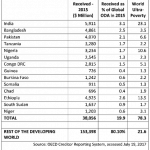The Hidden Impact of Microcredit: Three Under-recognized Ways the Industry Can Help Emerging Markets
In my last post, I argued that there is a case for social investment in microcredit under the status quo, since delivering microcredit is, on average, so cheap. That discussion presumed evaluating microcredit on the terms that the industry was built on: raising the income, investment and consumption of clients. It’s on those measures that the findings of the various randomized impact evaluations have been disappointing, at least in contrast to the rhetoric that was so prevalent during the microcredit boom years.
But just because household income and consumption measures were the basis of the original microcredit theory of change doesn’t mean that, 30 years on, we can’t learn from experience and consider other ways that microcredit may have had, and continues to have, an impact. Since emotions run strong on these topics, I feel that I have to begin with a couple of pre-emptive points of clarification: a) It makes no sense to criticize the impact evaluations of microcredit, or the discussion and presentation of those evaluations, for not taking alternative channels of impact into account – these alternative channels were not the chief ways that microcredit was supposedly having an impact; and b) It’s very important to keep the word “may” in the prior sentence; these channels have not been evaluated. I am not making a claim of impact, just speculating on other plausible effects of the microcredit industry that bear considering and perhaps integrating into thinking about the cost-effectiveness of further investment in microcredit.
One of these other channels is institution building, or the creation of a significant number of reasonably well-run and governed institutions in many contexts that lack them. David Roodman lands on this channel of impact in his book (you can see a reasonable overview of the impact through institution building in this post and the various links if your copy of “Due Diligence” isn’t to hand). This isn’t a particularly new perspective, as Roodman points out, but I still think it hasn’t gotten nearly enough attention. Anyone paying attention to the world these days is getting regular reminders of the importance of institutions, how hard they are to build and how easy to tear down. If current events aren’t sufficient, you can check out Acemoglu and Robinson’s “Why Nations Fail.” You’d have a difficult time making an argument that MFIs are more extractive or less inclusive than most of the institutions in the contexts in which they operate.
The institution-building channel, though, obscures another channel that is similar but operates more at the individual level. Development economists have long recognized that lower-income countries lack mid-size companies and other organizations. More recently, economists have come to see the importance of the “technology of management.” (If you’re interested in this idea, here’s a paper that thoroughly explains and documents the idea of management as technology and one that looks at the dearth of and impact of effective management practices in small firms in developing countries.) Effectively managing even moderately complex organizations is a learned skill – and there are few ways to learn the skill in an economy that lacks dynamic mid-size formal organizations. If you consider “investability” as a reasonable proxy for “well-run” organizations, under conservative assumptions, the 500-plus microfinance institutions in that category have collectively trained more than 50,000 people in the technology of management. And that training has been delivered at zero cost from social investors’ perspective given that most of that training happens simply by being in the job. The number of managers trained will continue to grow and those managers will spread through the economies of the countries they work in, amplifying the effect of their training (and transferring their knowledge to others). If you ignored the entire customer side of microcredit, and considered the industry solely as a “job training” or “management training” intervention, it’s plausible the industry could be one of the most cost-effective such programs attempted.
A third way that MFIs may have a long-term impact is in strengthening civil society. Well-functioning countries and economies rely on demanding citizens and customers who expect to be respected and well-treated. For many borrowers, a microfinance institution is one of the first formal organizations that has treated them fairly and with respect. In other words, microfinance institutions (at least those that put customer protection and customer service principles into action) have been training borrowers to be better customers and citizens by showing them how they can and should expect to be treated by other institutions. This isn’t a novel perspective on impact either, by the way. You can see this perspective in some of the stories in “Portfolios of the Poor” where households talk about how much they value the rules-based nature of MFIs, and in many of the anthropological/sociological studies of microcredit. But it can be traced at least all the way back to the Jewish scholar Maimonides, who reasoned that going into business with the poor was superior to most forms of giving because it treated them as equals and changed the outlook of the recipient (and the giver).
None of these channels of impact are likely to yield measurable or noticeable impact in the short or even medium term. But they are worth considering as plausible additional ways that investing in microfinance institutions can have an impact, and if you find any of them at least somewhat plausible, they bolster “The Case for Social Investment in Microcredit.”
Timothy Ogden is managing director of the Financial Access Initiative at NYU-Wagner.
Photo by McKay Savage via Flickr
- Categories
- Uncategorized



